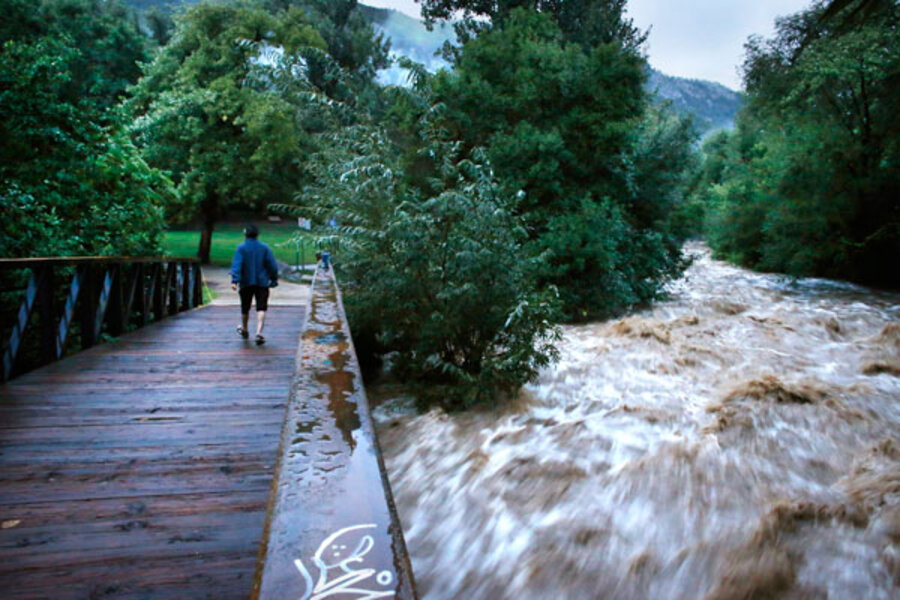Were Colorado floods result of global warming? Probably not.
Loading...
| Boulder, Colo.
The record-breaking storm that caused the Colorado floods has been called a “thousand-year event,” leading to speculation about whether the storm and flooding owed anything to climate change.
The answer, of course, is impossible to know for sure. But according to a panel of climate scientists from Colorado, the storm likely had little to do with climate change and more to do with an unusual confluence of atmospheric events.
It’s possible that some shifts due to climate change, such as increased water vapor in the air, may have exacerbated the effects of the storm slightly. But a storm in September 1938 was very similar in its footprint, its timing, and the type of rainfall (which was not the brief, intense thunderstorms typical here).
“Having seen the September 1938 analog should somewhat humble us, and remind us that nature has a way of delivering without human intervention in the climate system,” says Martin Hoerling, a research meteorologist at NOAA’s Earth System Research Laboratory in Boulder, Colo. “Climate change is operating, there’s no question about that, and water vapor has gone up,” but in this instance, climate change “really wasn’t a factor.”
Most striking about the recent storm was the sheer amounts of rain that fell in some areas. It set a new one-day record for rainfall in Boulder, 9.08 inches, that is almost double the previous record of 4.8 inches, set in 1919. The town, which averages just over 20 inches of rainfall in a year, has received 17.59 inches so far in September.
The storm was caused by a confluence of several unusual factors. A low-pressure system along the Utah-Nevada border helped pull a heavy plume of tropical moisture up from Mexico, a high-pressure system to the east pushed up even more moisture from the Gulf of Mexico, and a stalled front generated lift. All those factors set up a “blocking pattern” that helped keep the storm hovering over the same period for a long time.
Those events combining are highly unusual, said Klaus Wolter, a NOAA climate researcher who spoke at a panel discussion hosted by the Cooperative Institute for Research in Environmental Sciences (CIRES) at the University of Colorado and NOAA.
Climate change, he said, “could be a factor, but our models aren’t good enough to decide.”
Scientists agree that events like the Colorado storm “are playing out in an arena that is warmer and more moist,” says Jeff Lukas, a CIRES researcher.
But they debate the degree to which severe thunderstorms are exacerbated by human-caused global warming, though one new study published this week in the Proceedings of the National Academy of Sciences asserts that there is a definite link, and that there will likely be increased risk of such severe storms going forward if global warming continues.
“These events break records in ways that would not happen without climate change,” says Kevin Trenberth, a senior scientist in the Climate Analysis Section at the National Center for Atmospheric Research (NCAR), in an e-mail. “Climate change pushes 1 in 100 year events to be 1 in 1,000 year [events]. The damage is nonlinear: greatly amplified.”
That makes for a huge change in risk assessments, which “assume an unchanging climate, so what was a 500-year event is now a 30-year event,” he says.
Most scientists agree that the underlying climate conditions are shifting. Mr. Hoerling of the Earth System Research Laboratory helped edit a recent study that examined 19 analyses of 12 extreme global weather events in 2012; about half determined that human-caused climate change played a significant role.
“Every extreme weather event, like the five days of rain that produced the floods in Colorado, is occurring in a new changed climate base state,” says Gerald Meehl, a senior scientist at NCAR, in an e-mail. “The air is warmer, and warmer air holds more moisture… The convergence of conditions that produced the extreme rainfall in Colorado was something that occurred naturally, but the severity of the event likely had at least some contribution from these changes in the background state of the climate system.”






